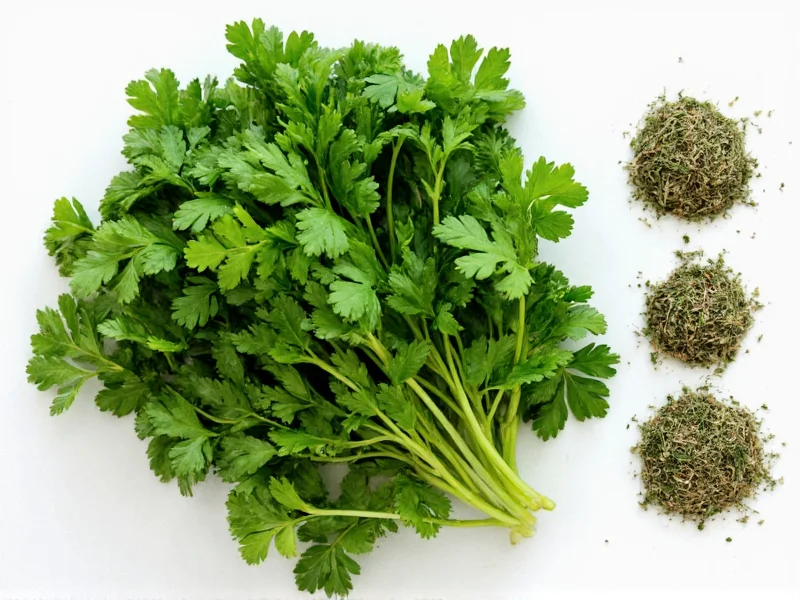Understanding herb conversions is essential for consistent cooking results. When substituting dried parsley for fresh (or vice versa), getting the measurements right prevents under-seasoned or overpowering dishes. The 3:1 ratio exists because dried herbs lose approximately 70-85% of their water content, concentrating their essential oils and flavor compounds.
Why Fresh and Dried Parsley Require Different Measurements
Parsley, like most herbs, contains significant moisture when fresh. During the drying process, this water evaporates, leaving behind a more potent concentration of flavor compounds. Dried parsley typically has about three times the flavor intensity of fresh parsley, hence the 3:1 conversion ratio.
This concentration principle applies to most leafy herbs, though exact ratios can vary slightly depending on the drying method and storage conditions. Properly stored dried parsley maintains its potency for 6-12 months, while fresh parsley lasts only 1-2 weeks in the refrigerator.
Fresh to Dried Parsley Conversion Chart
| Fresh Parsley | Dried Parsley | Best For |
|---|---|---|
| 3 teaspoons (1 tablespoon) | 1 teaspoon | Sauces, soups, stews |
| 1 tablespoon | 1/3 teaspoon | Dressings, marinades |
| 1/4 cup | 1 1/3 teaspoons | Rub mixes, stuffing |
| 1/2 cup | 2 2/3 teaspoons | Casseroles, baked dishes |
| 1 cup | 1/3 cup | Large batch cooking |
Practical Cooking Tips for Substitution
When converting fresh to dried parsley in recipes, consider these professional kitchen insights:
- Add dried herbs earlier: Incorporate dried parsley at the beginning of cooking to allow time for rehydration and flavor distribution, while fresh parsley should be added in the last 5-10 minutes.
- Adjust for dish type: For liquid-based recipes like soups and stews, use the standard 3:1 ratio. For dry rubs or baked goods, consider using 25% less dried parsley as flavors concentrate differently.
- Crush before using: Rub dried parsley between your fingers before adding to release essential oils and maximize flavor impact.
- Taste and adjust: Always taste your dish after incorporating dried herbs, as potency can vary between brands and storage conditions.
Flavor Profile Differences
Fresh and dried parsley offer distinct culinary experiences beyond simple measurement differences. Fresh parsley provides bright, grassy notes with subtle peppery undertones, while dried parsley develops earthier, more concentrated flavors with slightly muted brightness.
Chef's tip: For dishes where parsley is the star ingredient (like tabbouleh or chimichurri), always use fresh. For background seasoning in soups, stews, or sauces where parsley plays a supporting role, dried works perfectly well with proper conversion.
Storage Recommendations
Maximize the shelf life and potency of both forms:
- Fresh parsley: Store upright in a glass with 1 inch of water, covered loosely with a plastic bag in the refrigerator. Change water every 2 days. Properly stored, it lasts 1-2 weeks.
- Dried parsley: Keep in an airtight container away from light, heat, and moisture. Ideal storage extends potency for 6-12 months. Test potency by rubbing and smelling—if the aroma is weak, it's time to replace.
Common Conversion Mistakes to Avoid
Even experienced cooks sometimes misjudge fresh to dried herb conversions. Watch for these pitfalls:
- Assuming all herbs convert at 3:1: While most leafy herbs follow this ratio, exceptions exist (like basil which is closer to 2.5:1).
- Not accounting for age: Older dried herbs lose potency, potentially requiring slightly more than the standard conversion.
- Measuring incorrectly: Always measure dried herbs in teaspoons rather than eyeballing, as small differences significantly impact flavor.
- Adding dried herbs too late: Unlike fresh herbs, dried versions need time to rehydrate and release flavors during cooking.
When to Choose Fresh vs. Dried Parsley
The decision isn't just about conversion ratios—it's about culinary context:
- Use fresh parsley when: The herb is a featured ingredient, in cold dishes, for garnish, or when bright, grassy notes are essential.
- Use dried parsley when: Creating long-simmered dishes, when fresh isn't available, for consistent seasoning in commercial kitchens, or in spice blends.
Professional chefs often keep both forms on hand to leverage their unique properties. Understanding the fresh to dried parsley measurement conversion ensures your dishes maintain consistent flavor regardless of which form you use.
Frequently Asked Questions
Can I substitute dried parsley for fresh in all recipes?
While you can substitute dried parsley for fresh in most cooked dishes using the 3:1 conversion ratio, avoid substitution in raw applications like salads, tabbouleh, or as a fresh garnish where texture and bright flavor matter. Dried parsley won't provide the same visual appeal or fresh taste in these applications.
Why does the fresh to dried parsley conversion ratio matter for cooking?
The conversion ratio matters because dried parsley is significantly more concentrated in flavor after moisture removal. Using equal amounts would result in overpowering, potentially bitter dishes. Proper conversion ensures balanced seasoning and consistent results in your cooking.
How do I adjust recipes when converting from dried to fresh parsley?
When converting from dried to fresh parsley, use three times the amount of fresh parsley called for in the recipe. For example, if a recipe requires 1 teaspoon of dried parsley, use 1 tablespoon of fresh parsley instead. Remember to add fresh parsley later in the cooking process for optimal flavor retention.
Does the conversion ratio change for different parsley varieties?
The standard 3:1 conversion ratio applies to both curly and flat-leaf (Italian) parsley varieties. While flat-leaf parsley generally has slightly more intense flavor when fresh, the concentration during drying evens out these differences, making the same conversion ratio appropriate for both types.
What's the best way to test if my dried parsley is still potent enough to use?
Rub a small amount of dried parsley between your fingers and smell it. Fresh, potent dried parsley will release a strong, pleasant herbal aroma. If the scent is weak or barely noticeable, the parsley has lost most of its essential oils and should be replaced. Properly stored dried parsley maintains potency for 6-12 months.











 浙公网安备
33010002000092号
浙公网安备
33010002000092号 浙B2-20120091-4
浙B2-20120091-4